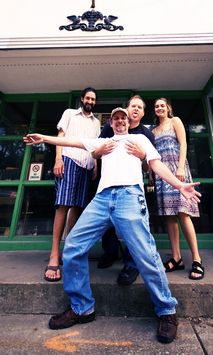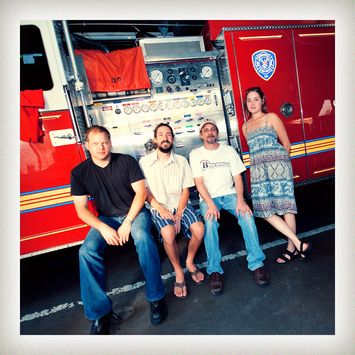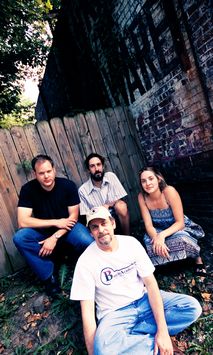social bookmarking tools:
 |
|
| Available RSS Feeds |
|---|
 - Top Picks - Top Picks |
 - Today's Music - Today's Music |
 - Editor's Blog - Editor's Blog
|
 - Articles - Articles
|
Add Louisville Music News' RSS Feed to Your Yahoo!
|

ARNETT HOLLOW: STORIES IN LIQUID BLUEGRASS
"The journey's rarely as you planned it in your mind."
The big bald guy flung open the door and poked his head out.
"You all are in a band, right?"
He didn't give them time to respond. "Who did the hippie version of 'Gin and Juice'?"
The four members of Arnett Hollow darted glances at each other, two of them made "uhhhhs."
He was impatient for an answer. "Don't know? Anybody know?"
Violinist Cheyenne Mize looked at the bald guy and said, "The hippie version or the lounge version?"
"It's what's playing in there right now." As if that would help. We were sitting outside. Musicians generally need to have a good set of ears in order to play and hear what's being played around them. But the ability to hear what goes on behind a wooden door with a heavy glass pane inset isn't a required skill.
There was a couple heartbeats' worth of pause, then Chris Rodahaffer, the band's guitarist and lead vocalist and lead songwriter, ventured, "Is it kind of a Bluegrassy one?"
"Everybody says it's Phish, but it's not." Another useless clue. Kind of like the person who goes into a bookstore and tells the clerk they're looking for something that's new from a guy who writes like Stephen King, but he's not, then gets snitty if the clerk doesn't know exactly what he's talking about.

"The Gourds?" cosmic banjo artist Glenn Miller asked.
"My buddy didn't believe me," the guy said. "I want somebody to verify it for me. If you were in a band, I figured you'd know it. That's cool."
He went back inside. "Yeah," Mize said, "we know all music everywhere."
We were seated around a plastic table outside the Dark Star Tavern on Frankfort Avenue, weather pleasant, air not a blanket of humidity as it normally would be on an early evening in late July in Louisville. A pair of Harleys was parked against the curb in front of us. One of them belonged to the terse bald guy who asked the "Gin and Juice" question. Next to them, Mize's candy-red and white Honda Metropolitan motor scooter sat like a smart-assed, mocking toy. Our conversation was interrupted by a train that rumbled down the track that runs parallel to the street, surprisingly noisy traffic and a shirtless guy with crooked glasses and a gut as round as a schoolroom globe walking his yapping pug.
"We started playing every Thursday up here," Rodahaffer said, tilting his head toward the building. "Kind of a place to explore."

The Dark Star occupies a building that once housed a restaurant that served soup and chili in bread bowls, then it was occupied an upscale restaurant that tried to make itself into a jazz club. Its name was the building's street address. Frankfort Avenue is the city's Bistro Row, home to more places to eat (hoity-toity and otherwise) than you'd see in an afternoon's programming on Food Network, especially the tree-shaded stretch of the road where the Dark Star is located. So the one business that has succeeded where two restaurants couldn't is a basic bar with a pair of pool tables, neon beer signs in the window and a space to hear live music. Not much different than one you'd find in any other area of town.
And in an inverse kind of parallel, Arnett Hollow is like that when it comes to their music. In Bluegrass, you expect to hear a common set of instrumentation: acoustic guitar, banjo, mandolin, fiddle, upright bass and someone to sing in a pinched voice about empty moonshine jugs, doomed love affairs and tiny towns in Tennessee. Arnett Hollow uses three of the common instruments, but drops the mandolin, the upright and the vocals singing praises of Corn Liquor and the Town That's Home Sweet Home to Us (even though we've never been there). Instead, the rhythm is carried by percussion (appropriately spare, as subtle as you would hear in a jazz ballad) and Chris Rodahaffer's vocals are mellow, expressive, like the best of the current Americana singer-songwriters.
So if the Dark Star Tavern is able to operate successfully out of a place where a white-linen-and-wine-list restaurant couldn't, Arnett Hollow is taking a form of music and succeeding at the way they have built their own sound into it. They're the octagonal peg that refused to be forced into a round hole. And their debut release After the Rain is proof.
"Every time I tried to play in a Bluegrass band," banjoist Miller reported, "they would try to play like Tony Rice. I wanna choke the next guy who wants to do that."
"I have a problem when people ask about the music," Mize said. "It's hard to say. If you mention Bluegrass, people assume a lot of things about it. But that's not what it is."
"Some of our stuff has a Cuban influence," percussionist Rob Edwards added. "Some have a jazz feel to them. Some of it has a rhythm-and-blues feel."
"It's a combination of all things that are good," Miller said. "Homemade Kentucky music. And that's what I like about it. This guy," he nodded toward Rodahaffer, "does his own thing. It's cool when somebody can do his own kind of music and it's not a cover of something or a rehash of a chord progression. It's all different."
The Arnett Hollow project (as a band and CD After the Rain) began with a visit to North Carolina. Rodahaffer was living in Boston, attending the Berklee College of Music and had traveled down to Boone, North Carolina to visit some friends who were attending Appalachian State University there. Just outside the city is a road called Arnett Hollow. It became the basis for the band name and the story their debut recording would tell.
"It started from a song Chris wrote called 'After the Rain,'" Miller said. "He came over one day and I said, 'Dude, you need to make more songs.' I listened to the song and it sounded like there were some unanswered questions about the flood, how it started and all that. The first seven songs [on After the Rain] tell that story."
It's a seven-song story as old as the Greek myth of Orpheus, one that carries through folktales and songs from the 19th and early 20th century. Which means it's not a happy one. Boy and girl live in a pleasant little town on a river. They enjoy their final hours together at a carnival. A torrential storm rolls through, bending the trees, heavy sheets of rain hammering the town, causing the river to flood and washing most of the town away. The boy had pleaded with the girl to meet him on the hill by the carnival's carousel, on higher ground and away from the water. She doesn't show. He paddles through the water-swollen streets calling for her. She doesn't reply. She's gone. But unlike Orpheus, he can't get her back. It's like an abridged, hill-bred version of Moulin Rouge! without the Can-Can concubines, absinthe junkies and Bohemian revolutionaries.
After the vague, oracular lyrics of After the Rain's "Prelude," a pair of instrumentals, "Arnett Hollow" and "Carnival," set a serene and joyous tone. There's almost a filmic sound to the two pieces, as if they were intended for a soundtrack, where Miller's banjo line in the first one coaxes you to visualize the clopping of horses down a dusty street and old Model-Ts clattering past them and the frenetic, flowing combination of banjo and guitar and wire-brush percussion drive the second piece so you can see the spinning of a Tilt-a-Whirl or a flying swing, or the up-and-down of a carousel horse.
The tempo drops with "Heavy Footsteps," which, along with real thunder in the background, announces the beginning of the rain and the story's sad ending is played out over three more tracks. Fortunately, the rest of After the Rain is balanced out with five more tracks, containing the uptempo "Hypnotized" and "Open My Eyes," that starts out with a three-note banjo riff similar to Beethoven's "Moonlight Sonata," then gradually changes over to a gypsy camp rondo.
The entire production showcases the different Bluegrass sound Arnett Hollow has. Instead of forcing the sound to fit the Bluegrass template (the round hole mentioned earlier) of intro/first verse/chorus/solo/second verse/chorus/solo and so on until the song ends, the pieces have more of a fluid structure within the instrumentation. It is as fluid as the waters that flood the town of Arnett Hollow in the story they tell, but not as overpowering.
"We're trying to have it not be anything," Miller said of the band's sound.
"We're still getting out sound together," said Edwards. "It's not like we have it all figured out."
The Arnett Hollow sound, indeed, is a departure not just from traditional Bluegrass, but from the type of music Rodahaffer, Miller and Edwards once made together in another band: Waddy Peytona. Named after the two Kentucky cities that share an exit ramp off Interstate 64 just east of Louisville, the band had no focus. And, apparently, no sense, either.
"Waddy was a drunkfest, man," Miller admitted. "Off the hook. There was no serious music like this band. Everyone here is seriously trained."
"Depends on what kind of training you mean," Mize said. "If it's playing on a stage, we have more training in that."
"I mean learning how to spin around on the ground with an electric pickup on my banjo. Like Curly of the Three Stooges," said Miller.
Antics like that are not entirely unheard of in Bluegrass. Back in the 1960s, The Stonemans, a family band, were known not just for their musical acrobatics, but also for their energetic dancing and stage antics during their shows. Their banjoist was Ronnie Stoneman, known best as the squealy voiced ironing-board lady Ida Lee Nagger in the regular short skit on Hee-Haw.
"They keep me on a chain like a tiger," Miller said. "When the show's going bad, they turn me loose."
"Sometimes he just clams up," Edwards said of Miller. "We can't get a word out of him. Only notes."
Miller continued. "When I was young, I used to go to rock shows. When Chris started coming over and recording, I wanted to be like that and not just a Bluegrass band. I was thinking more like Kiss or AC-DC."
Alleged burlesques aside, the members of Arnett Hollow do feel there is more focus on the music with the current project.
"Completing the recording was a big stepping stone in getting the sound together," Edwards said. "It was recorded with a banjo and a guitar first."
"And with a metronome," Miller added. "That way, when we brought [Rob] in, it would all be in time so that he could play along. You're supposed to put the drums down first, but we kind of did it wrong. Chris and I worked every night and the way he writes you just can't add standard banjo to it. So he had to show me how to do some things and I had to invent some completely new banjo techniques to help me get through probably half of that record."
"Even with the drums, you couldn't approach it with standard beats," Edwards said.
The entire work was home-recorded on a computer with two microphones (the thunder on "Heavy Footsteps" was recorded outside during a real storm, a microphone on a metal stand with a cable running from it to the computer tempting a lightning strike, while Rodahaffer and Miller enacted their versions of scenes from the movie Young Frankenstein: "Raise the kite higher, Igor!" "Yes, mahsteh.") It did give that track life, but neither guy had to bellow at the stormy sky to get it. Give my recording. . .liiiiifffe!
Later, Rob Collier added the bass tracks, then Cheyenne Mize was called in to add violin and backing vocals. She stayed to become a permanent member of the band.
"There were two songs on the record they had wanted some fiddle parts on," she said. "Then when I was listening to it, there were all these other songs that I added vocal parts to. I didn't know how it was going to go over because I didn't know these guys too well. Even for our CD release show, I felt like a special guest. Not really part of the band. I was always figuring out where I stood. But it didn't take long before I realized that it worked."
With mixing and mastering from John Torstrick and Dan Weigleb and artwork contributed by Rodahaffer's aunt Carolyn Young Hisel, After the Rain popped out as a quality do-it-yourself project, something that is becoming more and more common with musicians.
"If you're in a studio," Miller said, "you've got to get in and out because of your budget. Whereas, with our own studio we can record every night, a minimum of five nights a week for nine months and that's really what it takes. And with the way Chris writes, there's just no way you can go in and just play it. It's not that easy. And the technology's different. The equipment on his laptop is the equivalent of what people were making number one hits with in the 1970s. So it gives us the ability to record anywhere."
"But sometimes it's not the gear. It's the ear," Edwards contributed.
"And that's why it too so long. We've all got good ears."
All of which is not to say that recording studios will be obsolete because of the portable, home-based technology that Arnett Hollow and other performers are using to create their recordings. Studios are also using the same technology to work more efficiently. But for bands like Arnett Hollow and other experienced musicians, it is becoming easier and cost-effective to make the music in their own way, on their own time. And it also makes it easier to share stories like the one in After the Rain.
"There's so much music to me made," Rodahaffer said. "It's so easy to get that concept down to sound good."
"If you're an artist," said Edwards, "you have the ability to just do it. And you shouldn't let anything hold you back."
Don't hold yourself back. Get more liquid Bluegrass and stories at www.arnetthollow.com.
Special thanks to Sgt. Cliff Heil, Louisville Fire Department, for letting us in to Engine Co. 4 on Frankfort Avenue take some pictures.
